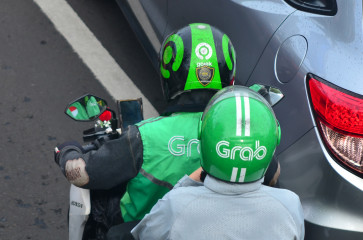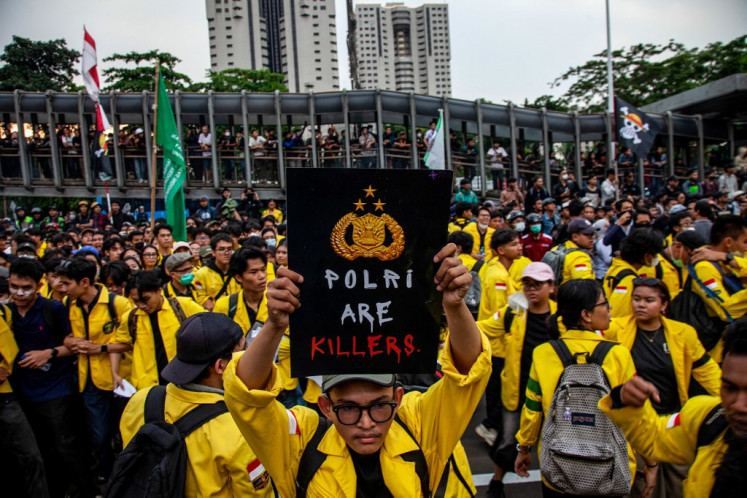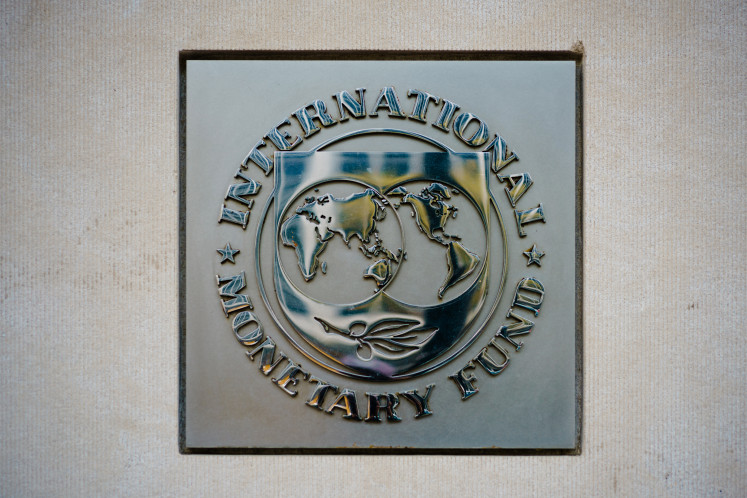Popular Reads
Top Results
Can't find what you're looking for?
View all search resultsPopular Reads
Top Results
Can't find what you're looking for?
View all search resultsContemplating Java
My Mind to Me is a Kingdom, by Ulil GamaThe image of Tobey Maguire in a Spiderman suit may vanish from your memory once you see a resin sculpture named Rolasan at the Van nJava art exhibition held at Taman Budaya in Yogyakarta
Change text size
Gift Premium Articles
to Anyone
M
span class="caption" style="width: 510px;">My Mind to Me is a Kingdom, by Ulil Gama
The image of Tobey Maguire in a Spiderman suit may vanish from your memory once you see a resin sculpture named Rolasan at the Van nJava art exhibition held at Taman Budaya in Yogyakarta.
Created by Yogyakarta artist Amboro Liring, Rolasan is a buck-tooth Spiderman sitting on the tip of the building as he eats traditional food wrapped in banana leaves with his right hand.
This superhero might be hungry after having saved lives in the city of gudeg (jackfruit stewed in coconut leaves), but in another perspective, the sculpture also shows that the Javanese people are admiring a Marvel comic character in their own way.
The five-day exhibition, which ended on Wednesday, was presented by Kelompok Sepi art group to celebrate their 15th anniversary. It boasted dozens of artworks by 41 artists and 13 sculptors expressing their thoughts and concerns over the identity of the Javanese people, who have been mingling with modernization and other cultures.
In a painting entitled Teman Imajinasi (Imaginary friend) by Yundhi Pra, there was a little girl staring at a small paper boat. But a similar orange color between the backdrop and the boat gave a distant impression between the two objects.
'Children used to make paper boats. I barely see them nowadays. Children now might only know of paper boats, but they don't make them or play with them,' Yundhi told The Jakarta Post.
Another piece of art that reminded us of children's games was Cerita Lama Bersemi Kembali (Old story rekindles), which was made by Ekwan. The colorful and playful painting depicted comical Javanese folk character Gatotkaca riding a toy elephant with some shredded parts.
Greg Susanto.
Wayang puppet characters were favorites of the exhibition as seen in Maha Wira Bhisma (Baratayuda War) by Andreas Bernadi and Wayang Jewer by Agus Nuryanto, but there were also other iconic daily life artworks that invited smiles.
One of them was Kerokan by Djagad Ngadianto. The man in the painting was wearing a typical tank top and a green sarong. He was giving his wife a kerokan treatment (the scraping of a back with the edge of a coin, which creates red welts), while his son studied the Javanese alphabet.
Another painting that gave a glimpse of market life in the village was Dawet Pasar by Bambang Lestari. It showed a woman wearing an old-fashioned kutu baru kebaya who was selling dawet (rice flour jelly in sweetened coconut milk) to customers in a traditional market.
Meanwhile, Sujiyanto's Masyarakat Madani (civil society) portrayed numerous daily activities in one frame. Looking closely at the artwork, visitors were able to see a small shop selling traditional snacks such as getuk lindri (cassava sweetmeat) next to a Pizzang Hut, a play on the famous American pizza chain.
Secretary of Kelompok Sepi Ouda Teda Ena says Javanese people are very adaptive in terms of behavior, language and fashion.
'For example, print is an English word, but Javanese people simply say ngeprin to claim the word in their language. Puritans may not like this, but this kind of adaptive character will be the one that exists,' he said.
Members of the art group come from various professional backgrounds. They formed the group to motivate each other and to be able to sell their artworks at higher prices.
Sepi, which stands for Seniman Pinggiran (Marginalized Artists), started with 20 active members in 1998 and later grew to 50 members. Ouda said his group managed to hold at least one big annual exhibition, while several members of the group often joined forces to hold smaller exhibitions.
He said the productivity of artists in Yogyakarta, including his group, was not likely to be influenced by the ups and downs of the art market because it was cheaper to hold exhibitions in the city than in Jakarta.
'Art exhibitions in Yogya aim to garner appreciation and critiques instead of selling works. How many pieces of art you sell is only one way to measure success,' he said.
' Photos courtesy of Sepi











